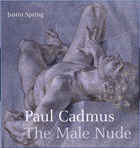
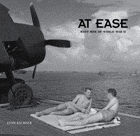
Jerry Flack is a retired professor of education from the University of Colorado. He lives in Denver, Colorado with his partner of fourteen years, who is also a retired educator. He loves reading, especially gay literature, and watching gay cinema (current favorites are "ROAD TRIP" and "GONE, BUT NOT FORGOTTEN"), and traveling throughout the glorious Southwest, especially in Santa Fe and Taos, New Mexico, and the Colorado Rockies.

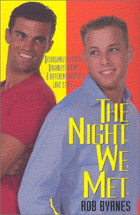 The Night We Met The Night We Metby Rob Byrnes Hardcover: 320 pages $23.00 Kensington Publishing, 2002 ISBN: 0758201931 The Night We Met is the perfect complement to the film Friends and Family since they both share much in common, especially slapstick humor, New York City organized crime, and gay men. In the very funny The Night We Met, Andrew Westlake is a largely unsuccessful writer and a lower echelon book editor who shows up for work less and less as the plot thickens. Most critically, Andrew is a hopeless romantic who has lost the man he believed to be the love of his life, the unfaithful Ted Langhorne. During his mourning period for the wayward Ted, Andrew finally finds love in the person of handsome Frank DiBenedetto only to discover that there are strings attached, and that the complications are GIGANTIC. Frank is closeted, engaged, and the only son of one of the Big Apple’s most powerful organized crime bosses. Just as in Friends and Family, the cast of characters in The Night We Met is both large and amusingly eccentric. On Andrew’s side there are his drinking pal, Denise Hanrahan, who is overly fond of wine and giving practical but loveless advice that he never takes, plus his stuffy but ever helpful gay boss, David Carlyle. Later, during Andrew’s get-away West Coast book tour that extends from Tacoma to San Diego, he meets up with fellow author Margaret Campbell, a tough, bourbon-drinking mystery writer with a BIG ATTITUDE whose latest bestseller is The Duct Tape Murder. Finally, there is a stealthy but handsome gay FBI agent who just happens to be furtively trailing Andrew as part of his organization’s ongoing investigation of the NYC Mob. On Frank’s side of the picture there is his betrothed, the treacherous Anna Franco, daughter of “Crazy Tommy” Franco and her real lover, Mafia goon Paulie Macarini. The impending nuptials of Frank and Anna are supposed to heal the wounds that exist between the two rival Mafia families, but there is no love lost between the couple, especially after Anna catches Frank and Andrew together in Frank’s plush apartment sans clothing immediately after the guys have consummated their love for the first time. Toss in drag queen Belle Bacall, Lauren’s faux niece and Andrew’s alter ego, plus the nationally syndicated, vulgar talk show host Gary Vine, who is really a front for the Mob, and one has a wacky set of characters all on the same collision course that is destined to produce sure-fire laughs. Here is a madcap romp that brings together organized crime, NYC police and the FBI, the publishing industry, and most importantly a genuinely sweet love story of a contemporary Romeo and Juliet (…or should one more truthfully say Romeo and Romeo?). The Night We Met is a delicious farce. The bullets fly fast and furious just like the very funny lines served up by author Rob Byrnes. Yet underneath all the gangland, book tour, and Belle Bacall joviality there is also a very engaging and charming love story about Andrew and Frank, two characters that readers will find irresistible. If the movie Friends and Family can be compared to The Godfather movie as directed by Mel Brooks, then The Night We Met just has to be Mario Puzo’s book of the same name as rewritten by David Sedaris. Don’t miss this gem of a novel or “Crazy Tommy” Franco’s might just whisper in your ear, “You’re gonna be sorry!” |
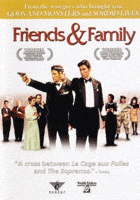 Friends
and Family - DVD Friends
and Family - DVDRegent Entertainment (Los Angeles, CA) Released by Wolfe Video, 2003, $24.95 Friends and Family is a very funny romantic comedy of errors that becomes more appealing with each viewing. The improbability of the plot only adds to the film’s screwball charm. As with many GLBT movies, there are family secrets but the central one is not that Stephen Torcelli and Danny Russo, the heroes of the film, are gay lovers and caterers as Stephen’s parents believe them to be, but rather that they are New York City Mafioso who are suave and sophisticated and VERY GOOD at their job as Don Victor Patrizzi’s chief lieutenants. Stephen’s father has his own secret, but that is still another tale. The perfect upper class world Stephen and Danny have made for themselves begins to unravel hilariously as Stephen’s mother Ada decides that the perfect 60th birthday gift for her husband Jack will be a surprise visit to their son and his lover Danny in New York City, highlighted with a birthday banquet catered by the boys. Then there are the Patrizzi family secrets. Stephen and Danny are the beloved hardball, no nonsense sons that the Don truly desires while his own less than macho sons, Vito and Frankie, want to cook and sew, respectively. His much tougher daughter Jenny has her special secret as well. She is engaged to marry Damon Jennings, a mild-mannered Random House editor who is neither Sicilian nor Catholic. And, to add even a bit more dementia to the proceedings, unknown to him, Damon’s fanatical parents have their little mystery surprise. In reality, they are the supreme leaders of a clandestine militia group from the Heartland that is planning to overthrow the government in a Second American Revolution. Ada’s bombshell announcement of she and Jack’s impending visit sets in motion a chain of events and comedy of errors that is a laugh riot from start to finish. The Patrizzi Family and organization owe Stephen and Danny so much that they cannot possibly fail to honor Stephen’s father with an over-the-top birthday banquet, or allow his parents to learn what the guys truly do for a living. (Caterers they are not; they cannot boil eggs or operate a microwave oven!) The Don begins to call in favors, not the least of which is an appearance at the birthday bash by United States Senator Peter Bloomer, deftly portrayed by Bruce Winant. The cast is perfect. Stephen and Danny as played by Greg Lauren and Christopher Gartin, respectively, are debonair, handsome, and as ruggedly masculine as any Mafia men could ever be expected to be, yet their love for each other is conspicuous and convincing. They are the happiest and most secure couple in the film, totally committed to one another. Indeed, they are the perfect advertisement for gay marriage. When a fellow Mobster inquires as to how they met, they quickly answer that they served in the Army Rangers together in the days before “Don’t ask, don’t tell” and proudly add in unison, “We asked.” “We told.” There are no passionate gay love scenes or kisses, but the looks and glances Danny and Stephen exchange, the unembarrassed use of the affectionate term “honey,” and their gentle hand holding even in the most tense moments of the film are bold testimony to their mutual love. “We are going to grow old together,” Stephen tells Danny just before the film’s uproarious climax. Greg Lauren and Christopher Gartin are reminiscent of and just as appealing as Cary Grant, the grand master of screwball comedies, the genre that Friends and Family most definitely represents. All of the performances are good, but several stand out. Tony Lo Bianco is a fitting Mafia Don, and the still gorgeous Anna Maria Alberghetti is terrific in a cameo appearance as his wife Stella. Tovah Feldshuh turns in a deliciously comic performance as Damon’s crazed militia-leading mother. Edward Hibbert and Meshach Taylor, the great African-American actor, are stellar as Richard and Bruno, the effeminate gay best friends of Danny’s and Stephen. The production values are also first class. The sets are classy and the cinematography shows off New York City at both its glorious and seedy best. The direction is also terrific with frenetic pacing that perfectly captures all the madcap madness of the story. If viewers think of the classic film, The Godfather, as Mel Brooks rather than Francis Ford Coppola might have directed it, they will have a near perfect notion of the fun of Friends and Family. The film has been criticized for its supposedly negative portrayal of queens or effeminate gay men, but such disapproval requires thoughtful examination. First, Danny and Stephen can no more help it that they are masculine hunks than Richard and Bruno can be blamed for being effeminate. Second, Richard and Bruno are, after all, best friends and confidants of Stephen and Danny. Third, none of the good-humored camp is ever mean-spirited and one can justifiably ask if it is not healthy for the GLBT community to enjoy and laugh at its varied images at least occasionally. Fourth, Richard and Bruno have two of the best lines in the film and play two critical roles in the crescendo that is the film’s finale. Richard has the balls (signed by all the New York Yankees, no less!) to correctly chastise Stephen for his internalized homophobia and forces him to honestly accept his homosexuality. Bruno tells a wonderful story about how ancient Persian artists always placed a flaw in their art to deliberately make it imperfect so as not to offend the gods; his story becomes a pivotal motif for the remainder of the film. Fifth, the drag queens (and that is still another hilarious story) and the effeminate gays -- in a kind of a post-Stonewall manner -- play a huge role in overpowering the evil militia. The queens definitely do themselves proud! Although Friends and Family is as light and airy as a fleecy cloud and produces a laugh a minute, it is not without significance in what it communicates to viewers about love between two men, among friends, and among families. Ultimately, with the much-deserved exception of Damon’s crazy parents and their dim-witted rightwing band of militia, everyone else finds love and happiness at the conclusion of this implausible but dreamily sweet, sidesplitting confection. “Don’t ask, don’t tell.” No way! Instead, “Don’t criticize. Enjoy! Enjoy!” And, you will fall in love with Friends and Family. |
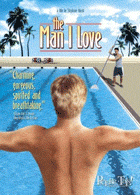 The Man I Love - DVD (Picture
This Home Video) Rating: Five Stars! The Best! The Man I Love - DVD (Picture
This Home Video) Rating: Five Stars! The Best!I love picture books for children and one of my favorites is The Yellow House: Vincent van Gogh & Paul Gauguin Side by Side created by Susan Goldman Rubin (Abrams, 2001). The book relates the story of the two months in the fall of 1888 when Van Gogh invited Gauguin to come live with him and paint in a glorious burst of mutually inspired creativity. Although there is no indication that either artist was gay, the parallels between Rubin’s beautiful storybook and director Stephane Giusti’s exquisite gay film, The Man I Love, are striking. Both settings are in the south of France, Arles and Marseilles, respectively. The two pairs of men share strikingly similar characteristics. Van Gogh was so excited about Gauguin impending visit that he painted the guest room of his yellow house another hue of yellow, created new gigantic yellow sunflower paintings to decorate the walls, and even included a chair made from yellow wood. Van Gogh was initially high-spirited and talked all the time. Gauguin was quiet, uncommunicative, and taciturn with little patience for Vincent’s extreme behaviors (It was after a quarrel with Gauguin that Van Gogh cut off of a piece of his ear and he died at the age of 37 having sold only one painting in his lifetime.) Martin, the AIDS victim in Giusti’s masterpiece is every bit as condemned to a tragic fate as Van Gogh was a century previously, yet he similarly embraces life and believes in the redeeming power of love. In the beginning of The Man I Love, Lucas, the straight-bisexual-gay (take your pick) second protagonist of the film is every bit as aloof, restrained, and unsympathetic to the irrepressible Martin as Gauguin was to Van Gogh’s exuberance and energy in Rubin’s story. But, by far the most revealing parallel between the book account of Vincent and Paul and the film is the breathtaking range of yellows that Giusti and his cinematographer use in scene after scene, masterfully spliced together on film, that strikingly resemble Van Gogh’s most awe-inspiring and ravishing yellow paintings of oil on canvas, especially sunflowers – his favorite subject. Just as Lucas learns from Martin in the film, Gauguin later in his life took to painting sunflowers just as Vincent did in Arles. The striking difference between The Yellow House and The Man I Love, aside from the obvious time periods and media, is that Lucas – unlike Gauguin -- is transformed by Martin’s unequivocal declarations of love as well as the self-discovery of his own humanity. His initial shock and annoyance with the outwardly and unashamedly gay attendant Martin at the same pool where he works as a lifeguard and practices diving is ever so gradually transformed into acceptance, tender caring, and ultimately, love. French filmmakers have an uncanny talent for telling love stories, or even fantasies of love as The Man I Love most likely is, better than filmmakers anywhere else in the world. The fact that this movie with its gay love story and strongly pro-Act Up political stance was originally made for French television is simply amazing. Moreover, the production values, especially the brilliantly yellow-saturated camera work, are superior to anything seen on American television. The radiant beauty of the cinematography is reminiscent of the golden age of Hollywood Technicolor films. The acting is uniformly superb, especially the two male leads, but give credit as well to the two talented actresses, Vittoria Scognamiglio and Mathilde Seigner, who are radiant in the roles of Martin’s protective mother and Lucas’s girlfriend Lise. Jean-Michel Portal as the angry confused, but ultimately loving Lucas is nothing short of miraculous and honestly convincing in the manner in which he changes and evolves into his own man. His caring for Martin is deeply moving. Marcial Di Fonzo Bo is utterly buoyant as the effervescent and life-loving Martin. His declaration of love to Lucas is astonishingly and refreshingly portrayed. A caveat. The Man I Love cannot be watched only once. The beauty of the film and the nuances of the evolving love story can only be truly appreciated with repeated viewings. This is a movie love story that should both excite and charm the gay community and should be required viewing for George W. and all others who perceive gay marriages as an evil threat to humanity. Those who use God as a weapon should view The Man I Love and realize that, in truth, He is love. The Man I Love is masterful in every way and should not be missed. |
 Paul Cadmus: the Male Nude Paul Cadmus: the Male Nudeby Justin Spring Hardcover: 160 pages Universe Publishing, 2002, $49.95 ISBN: 0789305895 Paul Cadmus was one of the great artists of the 20th century whose reputation and fame would almost certainly have been far greater had he not lived an openly gay lifestyle and have preferred be a realist in an era when abstract art dominated. Most damning, Cadmus was first and foremost an artist who specialized in figurative realism and who dwelt primarily upon the perfect symmetry and beauty of the male nude form as his subject matter. For six decades he created exquisite drawings of nude male models in a wide range of media that included chalk, pencil, crayon, watercolor, charcoal, and egg tempera that he often rendered on hand-toned paper. Although he concentrated on the beauty of the male body, his artwork is by no means sexually titillating. The meticulous drawing of Cadmus is no more pornographic than Michelangelo’s David. Cadmus deliberately distanced himself from works he considered to be examples of pornography. Indeed, in a letter written late in his life he rejected a request to include a reproduction of his most famous and controversial painting, The Fleet’s In! (see below) in a biography of Tom of Finland by F. Valentine Hooven. He wrote that while he was not ashamed of what he deemed as the honest homo-eroticism found in both his art and his life, he distanced himself from what he referred to as the “Sex, sex, sex” pornography that is perceived as “all pervading” in the work of Tom of Finland (p. 46). Cadmus was never a stranger to controversy, gay or otherwise. In 1931, he created the painting, Jerry that portrayed his lover of the time, Jared French, reclining on bed nude while reading a copy of the book Ulysses that had been smuggled into the U.S. where it was banned. The general content of his 1934 oil painting The Fleet’s In! is heterosexual, specifically sailors on shore leave. It was banned from a Public Works of Art exhibition in Washington, D.C., and provoked the Secretary of the Navy to describe it in Time magazine as “a most disgraceful, sordid, disreputable drunken brawl” that “originated in the depraved imagination” of the artist, Cadmus. (see Paul Cadmus by Lincoln Kirstein, p. 25). Cadmus was an extremely prolific artist whose oeuvre was first presented in Paul Cadmus (Chameleon Books, 1992) by his brother-in-law Lincoln Kirstein, but Kirsten’s work contained more of the great artist’s satirical style paintings that comment sardonically on American life in its many facets. The number of male nude figures represented was strictly limited. Now, Springs has created a volume devoted entirely to the male nude figure as seen through the eyes of this brilliant artist. Springs’s monograph is gorgeous with its 120 illustrations, 70 of them beautifully reproduced color plates. Springs commences his celebration of Cadmus’s work with a fascinating biographical narrative of the long life of the artist (1904-1999). He especially emphasizes that while much of the art that dominated the 20th century was abstract, Cadmus never moved away from realism, most especially the figurative paintings of the male form that he first observed as created by the great Italian Renaissance masters. The first 66 pages of the 175-page art book are devoted to an account of the artist’s personal history, his travels and work, and his position in 20th century American art. Although this section of the book is primarily text, it is well illustrated with art in varied media that include drawings, paintings, and photography. Self Portrait:Mallorca (1932) is also incorporated in this opening segment. Readers learn through Springs’s knowledgeable introduction that both parents of Cadmus were artist, indeed, virtually starving ones. The family was so poor that their two children not only suffered from malnutrition but rickets. Cadmus contemplated that his later interest in robust and healthy physiques in nude male models was the direct result of his own poorly developed, stunted growth, especially in the lack of development of a full-bodied, masculine chest. Readers also learn of his first love, Jared French, and the profound influence his first trip to Europe with French as his guide had upon his life work. Cadmus was profoundly influenced by the masters of the 16th century Italian Renaissance such as Michelangelo, Caravaggio, and Leonardo da Vinci and their logical approach to the nude male body and its beauty in their paintings and sculptures and that was characterized by a distinct homosexual identity. Cadmus was also greatly inspired by and followed in the rich tradition of artists Thomas Eakins and John Singer Sergent who were never ashamed to portray the male form in all its natural beauty, The naturalism of the male nudes that Cadmus rendered are often compared to the classic male body forms produced by the ancient Greeks. There is an incredible fluidity in his work as well as exceptional technical skill and virtuosity, and meticulous draftsmanship. He was a consummate artist with a vivid imagination. Cadmus breathtakingly unites body and spirit in his drawings. The remainder of this beautiful, richly published art volume is given over to Cadmus’s splendid drawings of the male figure in every conceivable position: kneeling, standing, stretching, viewed from the front, back, and side, or from laying on a bed to sitting in a chair, and from climbing stairs to gazing into a mirror in order to create the model’s artistic self-portrait. In addition to the varied poses, the models of Cadmus exude a wide range of human emotions including humor, secrecy, introspection, wistfulness, joy, placidity, peacefulness, happiness, and wistfulness. Virtually all the drawings portray the models fully nude. All of the Cadmus drawings are large with some spread across two complete pages. The artwork is handsomely reproduced and gracefully presented in this awe-inspiring coffee table book. In 1964, Cadmus met actor Jon Anderson by accident on Nantucket Island. Anderson became Cadmus’s primary model, best friend, and lover for the remaining years of his life, a 34-year working collaboration and personal partnership. From 1975 onward they shared a home. One of the amazing aspects of this stunning portrayal of a gay artist and his lifework is the longevity of the career and life of Paul Cadmus. While the front cover and endpapers are crayon drawings of male nudes, the back cover is an exquisite photograph of Cadmus, most likely in his twenties at the time, by the great American photographer George Platt Lynes. Partially nude, as captured on film by Lynes and thus fixed in time forever, Cadmus is a remarkable specimen of handsome masculinity himself (despite his own feelings to the contrary). To think this same young man spent the next sixty years of his life depicting some of the most beautiful images of the male form ever created is truly astonishing. Cadmus has received far too little attention as one of the great American fine artists of the past century and there are altogether far too few books of exceptional merit devoted to gay artists and their works. Happily, Justin Spring makes up for both of these omissions in a handsome book that should be widely circulated, viewed, and read. Paul Cadmus deserves an entirely new following that Spring’s tribute just might facilitate. That would be a wonderful memorial to a great artist who also just happened to be a gay man. |
 At
Ease: Navy Men of World War II At
Ease: Navy Men of World War IIby Evan Bachner Harry N. Abrams, 2004 ISBN: 0-8109-4805-2 Hardback, 160 pages, $35.00 It is easy to forget six decades later just how all involving and engrossing World War II was for the vast majority of American citizens. Figures in the arts were not exempt from contributing to the totality of the war effort. James Stewart, Clark Gable, and Henry Fonda were just three of the many film stars who served in the Armed Forces and Hollywood directors such as John Ford, Frank Capra, and John Huston enlisted and made documentary films to contribute their fair share to the war participation. Indeed, by the end of WWII, at least 25% of Hollywood’s male employees were fighting in uniform for the USA. Famed photographers also became involved in the war endeavor, often as documentary artists. One of the latter was the great photographer Captain Edward J. Steichen, creator of “The Family of Man,” the most successful book of photography ever created, who first served as a documentary photographer in World War I and was accepted at the ripe old age of sixty-one, following the attack on Pearl Harbor, to create the Naval Aviation Photographic Unit initially with six photographers to document the roles played by American men serving in the U.S. Navy during World War II. Steichen’s unit was never intended to create a set of battle photographs. Rather, their assignment was to capture on film the daily lives of men from all across the nation and the globe as they were mobilized, trained, built ships, were transported at sea, and only ultimately experienced naval combat. Evan Bachner, whose father Arthur Bachner served as a corporal in Marine Corps during World War II, has brought into being a book that presents young American men in their prime in the early 1940s, during some of the darkest hours in the nation’s history when it was at war with Italy, Germany, and Japan. At Ease is a brilliant document of American warriors at sea, most especially in the Pacific Theatre of World War II. The images of young American manhood appear as fresh today as they were in the years from 1941-1945. One of the star photographers of Steichen’s team was Horace Bristol, a contemporary of Dorothea Lange, Edward Weston, and Ansel Adams. Bristol and other members of Steichen’s Naval Aviation Photographic Unit spread out across the globe, taking thousands upon thousands of black-and-white photographs of Navy crews in training, involved in all aspects of shipboard life, during the occupation of Italy, and especially teeming with life aboard aircraft carriers in the Pacific. More than 15,000 images were printed by Stechen’s unit and Bachner spent six years culling the very best of these images in the National Archives to truly present a portrait of American military men, mostly at ease, as they sunbathed, showered, fueled and armed planes, conducted target practice, read letters from home, worked as mechanics and ground crews, kept in top physical condition, underwent physical examination and training, and worked and bonded aboard naval vessels such as the USS Lexington, USS Enterprise, the USS Santee, and the USS Ticonderoga. At Ease: Navy Men of World War II presents a provocative glance at the lives of men stealing away moments of peace, quiet, fun, and camaraderie in what must have been altogether one of the most hellish moments in the history of humanity. Here are sailors that faced atrocities best forgotten, but in that time they also found moments of brotherhood, time for a civil game of checkers, leave in Honolulu or Ceylon, or a nude swim in Corsica. Whether showering, showing off a new tattoo, grabbing a quick beer, or being on the receiving end of a welcome rub down, these Navy men are shown in great photographs that document a side of the war never seen before. The photographs are miracles. Thanks to the captivating nature of film, these men have not aged one minute beyond the exposures. Men are shown writing what well might be their final letter home before the invasion of the Philippines, but they are never shown regretting the heroic service they paid to their country in doing their duty. At Ease is a book just begging to be placed at the center of your coffee table and waiting for many, many repeated viewings through its handsome pages of virile American manhood. |
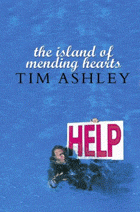 The Island of Mending Hearts The Island of Mending Heartsby Tim Ashley Paper 300 pages Gay Men's Press, 2004 ISBN: 1902852478 The Island of Mending Hearts opens with what may well be the most provocative sentences found in any novel this year: "Suicide is like masturbation; they both like to veil their obscenity with metaphor, using the back doors of language to introduce their unacceptable intent. So I wasn't going to kill myself; I just wanted to end it all." After failing to save the most important person in his life, forty-something Michael Stuart, a London heart specialist, leaves England aboard a cruise ship destined for the Caribbean. He is intent on committing suicide during the Atlantic crossing, but he waits too long and finds himself on a Sunday morning disembarking in the port of Key West, Florida, more adrift on land than he ever was at sea. He has a severe hangover and finds himself in search of food to stave off the hunger of his weary and abused body. Truthfully, he is more in need of the provisions that will mend his broken heart and heal his wounded soul. Michael never plans to remain in Key West any longer than the length of a breakfast meal, but circumstances and life change, one of the prevailing themes of Mending Hearts, and he finds himself surprisingly extending his stay and discovering both peace and love in this miraculous place of wonder that is the southernmost point of Florida, closer to Cuba than it is to Miami. Michael set sail to end his life, but he finds an unexpected voyage of self-discovery on an island just made for the lost and lonely. Although he is a physician by training and practice, he finds healing neither in a hospital nor from help proffered by his former colleagues, but rather from the coterie of friends he makes who are a wondrous mixture of people who defy narrow classifications of gender, ethnicity, race, sexual orientation, or wealth. The inhabitants of Key West are quite simply people who are fully alive and exceptionally humane. To state that The Island of Mending Hearts is filled with surprises is a gross understatement. The narrative is complex and filled with countless stories, yet the personal chronicles are woven together seamlessly. The novel is so richly textured and polished that it is impossible to believe that it represents author Tim Ashley’s first work of fiction, The writing is truly amazing and graceful for a first-time author. The Island of Mending Hearts is a poignant and life-affirming novel that is beautifully composed. Tim Ashley’s novel reveals a complex and multifaceted story line that ranges across such varied subjects as relationships betweens gays and straights, gay men and lesbians, race and ethnicity, families of all different kinds –- loving and dysfunctional, gay and straight -- and the secrets that they keep, the incredible damage loveless and unfeeling parents inflict upon their children, the contemplation of suicide, love and redemption, nineteenth century portrait painting, plus the geography, history, art, and architecture of Key West, and, yes, even the lives of parrots. Rarely has an author’s reach been so great, but it never exceeds his grasp. Much of the joy of this life-affirming novel comes from the collection of rich, fully developed characters that Ashley creates. In Key West, there are Sue and Alex, the gay and lesbian partners who operate the Blue Lagoon Cafe and who are also married so as to outmaneuver the particular eccentricities of an archaic will that would deny Alex the historical home that is his birthright. Alex is unselfish, loving, and a balm to the badly wounded Michael. There is also the Zen-like Penny Heron, who owns Penny’s Paradise Guesthouse and is Sue’s real lover. Penny is 6’ 2” tall, a former opera singer, and wears colorfully flamboyant clothing. She is filled with wisdom that she is never shy about imparting to others. Penny is perceptive and she becomes Michael’s conscience, spiritual guide, and mentor, explaining the real Key West to him: “Half the people here are recovering from broken hearts.” She herself came to Key West one day too late to say her final good-byes to Carey, her AIDS-stricken brother. Then there is Carey’s wealthy former lover Karl and his architect friend Angelico, and everyone’s ally Phil, who becomes Michael’s personal clothing guru at the local Banana Republic outlet, while her genuine passion is singing the blues. She is a consummate artist whose haunting rendition of “Somewhere Over the Rainbow” opens the floodgates of tears of all who listen to her remarkably sensitive interpretation. In, Toronto, there is Michael’s beloved sister Lolly who has just given birth to his twin nephews, named after himself and his beloved James. There is also Pete, Lolly’s tender and adoring husband. Left behind in London are Selena, Michael’s estranged and calculating wife, and his cold and unfeeling, military-bearing father. Finally, there are all the ghosts whom readers come to know only through the stories of others. There is Michael’s mother and his precious James plus his adoring grandparents who lived on the north Norfolk coast of England. There is the extraordinarily handsome Carey, still loved passionately by both his sister Penny and his lover Karl. There is the deceased Aunt Penny, truthfully Alex’s generous, but unconventional great aunt who has willed him her ramshackle Key West mansion. Finally, there are Amos and Juan, the American and Cuban secret male lovers of at least a century past. It would spoil a splendid story to reveal how all these varied pieces of a gigantic and complex human puzzle ultimately fit together. Suffice it to say, that surprises, both happy and distressing, build upon one another to reach a remarkable conclusion that is both believable and evocatively beautiful. In the end, Michael needs neither suicide nor masturbation. He has discovered the island of mending hearts and he has been healed. Moreover, although he is a doctor of medicine himself – indeed, a heart specialist – he learns to reclaim lives, and to make others well in ways that he was never taught in medical school. The Island of Mending Hearts is to be savored, appreciated and valued. It is filled with infinite wisdom and is itself, all heart. |